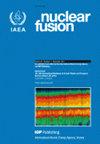利用人工神经网络模型预测 EAST 托卡马克中的等离子体旋转速度和离子温度曲线
IF 4
1区 物理与天体物理
Q1 PHYSICS, FLUIDS & PLASMAS
引用次数: 0
摘要
根据 X 射线晶体光谱仪的光谱测量结果,开发了人工神经网络模型来预测 EAST 托卡马克的旋转速度和离子温度曲线。深度神经网络(DNN)和卷积神经网络(CNN)模型都被用来推断线积分离子温度。这两种模型的预测结果与目标值具有很强的相关性,为交叉验证提供了机会,从而提高了预测的准确性。值得注意的是,这些模型的计算速度有了显著提高,超过传统方法十倍以上。此外,对输入数据范围和误差预测的研究为未来的自动计算过程奠定了基础。最后,CNN 还被用于预测线积分旋转速度剖面和反转离子温度剖面,以确保其在训练过程中的鲁棒性。值得注意的是,这些算法并不局限于任何特定的物理模型,可随时适用于各种融合设备。本文章由计算机程序翻译,如有差异,请以英文原文为准。
Prediction of plasma rotation velocity and ion temperature profiles in EAST Tokamak using artificial neural network models
Artificial neural network models have been developed to predict rotation velocity and ion temperature profiles on the EAST tokamak based on spectral measurements from the x-ray crystal spectrometer. Both Deep Neural Network (DNN) and Convolutional Neural Network (CNN) models have been employed to infer line-integrated ion temperatures. The predicted results from these two models exhibit a strong correlation with the target values, providing an opportunity for cross-validation to enhance prediction accuracy. Notably, the computational speed of these models has been significantly increased, surpassing traditional methods by over tenfold. Furthermore, the investigation of input data range and error prediction serves as the foundation for future automated calculation process. Finally, CNNs have also been employed to predict line-integrated rotation velocity profiles and inverted ion temperature profiles for their robustness in the training process. It is noted that these algorithms are not restricted to any specific physics model and can be readily adapted to various fusion devices.
求助全文
通过发布文献求助,成功后即可免费获取论文全文。
去求助
来源期刊

Nuclear Fusion
物理-物理:核物理
CiteScore
6.30
自引率
39.40%
发文量
411
审稿时长
2.6 months
期刊介绍:
Nuclear Fusion publishes articles making significant advances to the field of controlled thermonuclear fusion. The journal scope includes:
-the production, heating and confinement of high temperature plasmas;
-the physical properties of such plasmas;
-the experimental or theoretical methods of exploring or explaining them;
-fusion reactor physics;
-reactor concepts; and
-fusion technologies.
The journal has a dedicated Associate Editor for inertial confinement fusion.
 求助内容:
求助内容: 应助结果提醒方式:
应助结果提醒方式:


